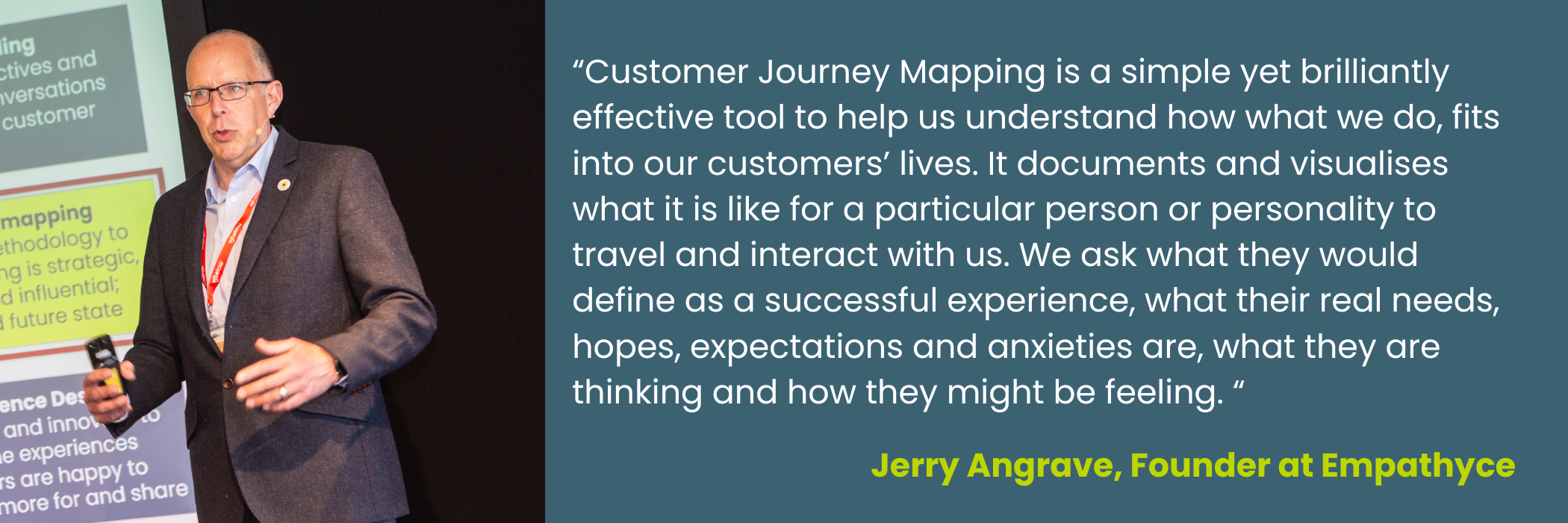18 March 2024 | Blog
5 reasons why your travel brand should invest in Customer Journey Mapping
The value of customer experience (CX) optimisation can be difficult to measure, sometimes leaving travel brand leaders nervous about investing in it, unsure of the financial return it will deliver. Businesses need measurable reasons to invest in an effective customer experience strategy.
Travel Customer Experience (CX) expert and founder of customer experience consultancy Empathyce, Jerry Angrave, has been a long-term partner of 15below, presenting at our events, conducting workshops, and collaborating with us to enhance passenger journeys. We recently partnered with Jerry to produce a free eGuide dedicated to Customer Journey Mapping - 'Ensuring your Customer Journey Mapping is effective, strategic, and influential'.
With his expertise and role in the Heathrow Accessibility Advisory Committee, we asked for his insights on why Customer Journey Mapping is now indispensable for travel brands:
What is Customer Journey Mapping?

After a lot of hard work, you are ready to set up your journey mapping workshop. You’ve defined the scope, you’ve booked a date in the diary and you've planned the structure of your session. You send out an invitation to colleagues and partners, explaining how their perspective is crucial, and their contribution will be much appreciated.
It’s an exciting prospect. And then inevitably, you get someone - or their line manager - asking “Why?” Of course, they’re busy and they need a good reason to step away from their day job.
Being the one tasked with the thinking and doing around customer experience is never easy, especially when others have different priorities. It’s a balancing act, convincing others that we can help them succeed if they could help us too with their time, expertise, and people.
Customer experience needs to earn its credibility in the organisation if it is to be effective across all divisions and functions. For me, there is no better way to build a solid foundation for that than journey mapping. Not just the visual representation of what it’s like to be a customer, but then also as a tool to highlight the real impact we have on our customers’ lives in a way that influences, and drives customer-led change.

Source: Watermark Consulting
Whether you are setting out to improve the experience of booking confirmations, disrupted flights or mobile check-in, here are five reasons to prove to unsure stakeholders that Customer Journey Mapping is not a nice-to-have, but a commercial imperative.
1) It’s not just about creating better journeys, it’s value-driven and commercially focused
Customer experience journey mapping isn’t about finding ways to interact with a customer at every opportunity. Absolutely, it will highlight those opportunities where you can do things better and differently to anyone else. But mostly, it shows how well we do the things that passengers value most.
Because it is centred around what the customer needs to happen, what they hope for, expect, and find frustrating, it also shows where you might be carrying unnecessary costs through duplicated efforts or doing things customers don’t need or value.
The customer focus means the outputs highlight what drives or erodes value for our commercial results and the impact on our brand.
Top tip for travel brands:
The point is to create a stronger business by creating fewer poor, and ultimately more positive experiences and memories for our customers; ones that keep them coming back and telling everyone to do the same.
2) It’s strategically supportive
Customer experience is not one person’s project. It’s not the responsibility of a CX team or someone in the Marketing, Commercial or the Customer Operations team, trying to increase a score or individual measure.
Journey mapping exists to show how a focus on customers can deliver real outcomes for the business overall. If the commercial strategy says it will focus on a particular traveller type, that’s the persona you will use in your workshops. If the brand promises to give ‘outstanding’ experiences, your journey mapping will show what that needs to look like - read more about this in our guide.
It also helps to understand what data should be collected, and what customer metrics should be tracked throughout the journey.
Top tip for travel brands:
We need to show how well the travel brand is performing against its strategic goals, not just an attempt at measuring customer satisfaction, because everyone else does that too.
Creating a travel customer journey map will not be done in isolation. The insights generated will also prove invaluable for other ‘transformation’ programmes around the business, helping to prioritise activities and adding the customer perspective where it’s needed.
3) It creates momentum
Completing a productive journey mapping workshop is just the beginning.
You will engage others in analysing the outputs and prioritising what you will do next. You will speak to ‘real’ customers to validate your internal view. You will create stories to share around the business and get others involved. You will plan more journeys and persona experiences to map out and investigate.
It is one of the most visible, tangible, and enjoyable CX activities. In doing so, it creates interest and engagement.
Top tip for travel brands:
People get to hear about your workshop and the wider CX programme and when you reach out to them, they want to be a part of it.
It does also create expectations, so be prepared to share the next steps, to keep people updated, and share the outputs. Keep them engaged – those who came to your workshop can easily become your group of CX champions around the business.
4) It adds credibility to the CX agenda
By the time your recommendations for improvements and changes are made, your case is almost finalised. You have looked at it from a customer persona perspective, understood how the travel brand's issues affect them differently at various times, gathered input from around the business, and validated the conclusions with real customers.
You have applied your insights and you know the most likely impact. Your case for change is ready and those approving decisions at the highest level will be reassured that you have considered the options, taken an educated and pragmatic approach, and looked at all the risks.
And, as you dig deeper into your journey mapping, you can find ways to collaborate with even the most doubtful stakeholders. You will have spent time with them to understand their world, their challenges, and their goals. Your journey mapping will uncover ways they can achieve their goals in a more customer-centric way.
Top tip for travel brands:
The reality is that sometimes your stakeholders won’t show much interest until the leadership team shows how committed they are. At that point, when those around you see the value in it, the work you have done stands out and is recognised.

Source: Bare International
5) It helps prioritise experience improvements
Through this exercise, we’re looking for, what to change, what to keep, what to start or stop doing, and what we need more information and data about. The aim is to know what we need to do that will secure customers’ loyalty and advocacy.
The journey mapping workshop will generate hundreds of thoughts and ideas. The team in your workshop will have voted on the challenges and opportunities they feel are a priority. You know what your strategic aims are as a travel brand and what your biggest issues are. You now know what customers value the most and you know how well you do those things.
The net result is that you can identify the top tactical, strategic, and cultural actions for customers, colleagues and partners and build an informed roadmap of planning, delivery, and monitoring.
Journey mapping really is the gift that keeps on giving to your passenger experience programme. I’ve only covered some of the benefits here, but the list goes on; you’ll find the journey mapping framework included in our guide, which helps to organise the thinking and breaks it down into manageable and focused actions.
You can apply the principles of journey mapping to colleagues joining the company or to those handling customer enquiries. Those who join your workshops – even if they were told at the last minute by their boss to join you - build new relationships, they learn more about their own organisation, and gain a better understanding of the role they can play in improving passengers’ experiences. They will be able to see how CX links to other initiatives and programmes and bring new ideas from their own perspectives and roles if they understand the importance of Customer Journey Mapping.
And, quite possibly for the first time, the entire organisation and its partners are brought together behind a common perspective – that of your customers.
Journey mapping always needs to be strategically aligned, efficient in its delivery, and must generate influential insights. But I would always advocate that whether it’s with a team of 20 or just you, see where journey mapping takes you. It won’t let you down.

Top tip for travel brands:
Download “Ensuring your Customer Journey Mapping is effective, strategic, and influential” here for a guide on how to run your own journey mapping workshops or contact our team for more information.




